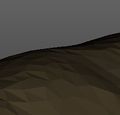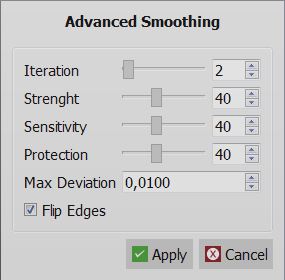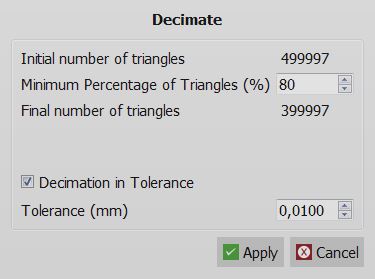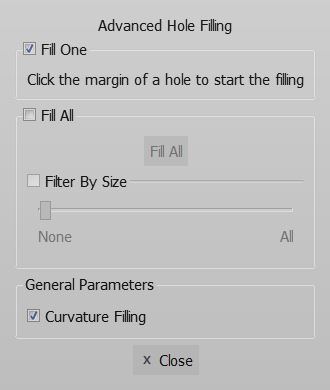Difference between revisions of "Man MeshEditing/de"
(Created page with " Auf „Ausführen“ klicken, um das Ergebnis des Vorgangs zu sehen.") |
(Created page with "== Mesh vereinfachen ==") |
||
| Line 61: | Line 61: | ||
Auf „Ausführen“ klicken, um das Ergebnis des Vorgangs zu sehen. | Auf „Ausführen“ klicken, um das Ergebnis des Vorgangs zu sehen. | ||
| − | == | + | == Mesh vereinfachen == |
This tool takes a selection of the mesh and it removes all the details, leaving the surface as plane as possible. It removes holes, spikes, noises. To use this tool: | This tool takes a selection of the mesh and it removes all the details, leaving the surface as plane as possible. It removes holes, spikes, noises. To use this tool: | ||
Revision as of 10:29, 1 February 2016
Contents
Meshbearbeitung
Nach der Konversion ins Meshformat, könnten einige Änderungen notwendig sein, um die Daten für den gewünschten Verwendungszweck möglichst geeignet zu machen.
Die Meshes könnten Makel, Rauschen oder Löcher aufweisen, die entfernt werden müssen.
OpticalRevEng Dental verwendet automatisch elementspezifische Mesherstellungsmethoden. Es könnte allerdings notwendig sein, die Daten noch zu bearbeiten, bevor man sie in eine andere Software exportiert.
Hier werden die Bearbeitungswerkzeuge der Meshes beschrieben, die sowohl Mesh Menü oder in der Meshwerkzeugleiste verfügbar sind.
Spitzen löschen
Als Spitze wird bei einem Mesh ein winziger Oberflächenteil bezeichnet, der nicht wirklich Teil des gescannten 3D-Objekts ist.
Im Allgemeinen werden Spitzen bei der Mesherstellung automatisch entfernt: Bei von anderen Systemen importierten Meshes könnten diese jedoch zu finden sein.
Dieses Werkzeug entfernt Spitzen automatisch und repariert das Mesh automatisch.
Feilen der Meshes
Dieses Werkzeug poliert die flachen Oberflächenteile und schleift gleichzeitig die Meshränder ab. Diese Funktion hat 2 Parameter:
- T [°] : Dieser Winkel bestimmt, was ein Rand ist. Alle Oberflächenteile, deren Winkel spitzer als T° ist, werden abgeschliffen. Wenn der Wert bei Null liegt, wird die ganze Oberfläche poliert.
- Wiederholungen: Wie viele Male die Software die Oberfläche abschleift. Je höher der Wert ist, desto mehr wird die Oberfläche poliert bzw. abgeschliffen.
Die Software benutzt dieses Werkzeug automatisch und nach bestimmten Parametern. Die Benutzung des Werkzeugs bei nicht optimalen Parametern könnte Form und Größe des Objekts ändern.
Mesh glätten
Diese Funktion, die dem Feilen ähnelt, glättet die Objektsoberfläche ohne die Ränder zu behalten.
Die Software benutzt dieses Werkzeug automatisch und nach bestimmten Parametern. Die Benutzung des Werkzeugs bei nicht optimalen Parametern könnte Form und Größe des Objekts ändern.
.
.
.
Mesh dezimieren
Dieses Werkzeug verringert die Anzahl Dreiecken in einem Mesh, um kleinere Files zu erstellen und versucht, möglichst viele Details zu behalten.
Der erste Wert beschreibt die Anzahl der ursprünglichen Dreiecke der ausgewählten Meshes.
Es ist möglich, den zu erhaltenden Dreieckprozentsatz zu bestimmen (z.B. ein Wert von 50% halbiert die Anzahl Dreiecke).
Es ist außerdem möglich, einen Toleranzwert einzustellen. Wenn der Toleranzwert aktiviert wird, stoppt die Software die Dezimierung, bevor das Mesh über den eingestellte Wert bearbeitet wird.
Auf „Ausführen“ klicken, um das Ergebnis des Vorgangs zu sehen.
Mesh vereinfachen
This tool takes a selection of the mesh and it removes all the details, leaving the surface as plane as possible. It removes holes, spikes, noises. To use this tool:
- Select the area in which it is necessary to remove all the features with the Selection Tools
- Apply the Mesh Defeature
Catenate
This tool can be used only in Free Mode. It takes all the selected meshes and creates a single mesh, merging all of the selected meshes together.
Flip Normals
Every mesh has an inside and an outside. The software gives them two different colors. This tool inverts the inside and the outside of the selected meshes.
Fill All Holes
This is an interactive tool that allows to fill the holes in the currently selected mesh.
This tool can work in 2 different ways
Fill One
In the fill one mode, the software will highlight the hole near the mouse cursor. By clicking with the left mouse button on the highlighted hole it will be filed.
Fill All
In the fill all mode, the software will try to close all the holes. With the Filter By Size function, it is possible to select all the holes below one size and fill them. The selected holes will be highlighted in real time by the sofware.
Curvature Filling
There is an additional option: curvature filling. If this option is enabled, the software will try to close the hole following the curvature of the rest of the surface. If it's disabled, the software will ignore the rest of the surface and close the hole with a straight plane.
Close Denture
When scanning a whole jaw, the base information will not be acquired. This tool has been created to recreate that information. Closing the dunture with the Fill All Holes tool takes too much time and the final result will not be good enough.
With the close denture tool, the mesh will be closed with a perfect plane in a reduced amount of time.
Fix Mesh
Removes all the possible defects and noises of a mesh.
Mesh Offset
This tool creates a bigger/smaller version of the selected mesh. The Offset [mm] parameter allows to select how much the mesh will change.
The three flags (Remesh, Sharpen and Optimize Vertices) have to be checked.
Usually, none of these tools is necessary to work because the strategies already apply a selected sequence of specific tools to each element.







